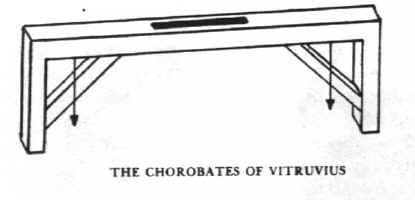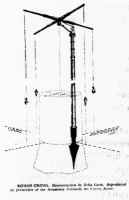|
 Article taken from "Backsights"
Magazine published by Surveyors Historical Society
Article taken from "Backsights"
Magazine published by Surveyors Historical Society
|
Two
learned Romans, Marcus Vitruvius Pollio, and Sextus Julius Frontinus, wrote of
surveying practices in the Roman Empire at the time of Christ. Undoubtedly
there were more works from their time, but many classical works were
irretrievably lost in the destruction of the Alexandrian library in 642 A.D.
 Marcus
Vitruvius Pollio, a master of architecture, presented De Architectura Libri
Decem (10 books) to this patron Augustus Caesar, about 20 B.C. Vitruvius
wrote of the CHOROBATES, an instrument used for leveling hydraulic gradients to
cities and houses. The water supply for Rome alone was comprised of ten
great a aqueducts, some coming from lakes as far as sixty miles from the city.
The CHOROBATES is described as a rod 20 feet long with duplicate legs attached
perpendicularly at each end. Diagonal pieces connect the rod and the legs,
and both diagonal members have vertical lines scriven into them, over which
plumb bobs are hung. When the instrument is in position, and the
plumb-lines strike both the scribe-lines alike, they show the instrument is
level. If the wind interferes with the plumb lines, the water level at the
top of the horizontal piece is used. Vitruvius instructs that the water
level groove was to be "five feel long, one digit wide, and a digit and a
half deep". By using two or more chorobates, established levelly, the
vertical distance between instruments could be established by sighting along the
depth of the uphill instrument, to a rod placed atop the lower chorobate. Marcus
Vitruvius Pollio, a master of architecture, presented De Architectura Libri
Decem (10 books) to this patron Augustus Caesar, about 20 B.C. Vitruvius
wrote of the CHOROBATES, an instrument used for leveling hydraulic gradients to
cities and houses. The water supply for Rome alone was comprised of ten
great a aqueducts, some coming from lakes as far as sixty miles from the city.
The CHOROBATES is described as a rod 20 feet long with duplicate legs attached
perpendicularly at each end. Diagonal pieces connect the rod and the legs,
and both diagonal members have vertical lines scriven into them, over which
plumb bobs are hung. When the instrument is in position, and the
plumb-lines strike both the scribe-lines alike, they show the instrument is
level. If the wind interferes with the plumb lines, the water level at the
top of the horizontal piece is used. Vitruvius instructs that the water
level groove was to be "five feel long, one digit wide, and a digit and a
half deep". By using two or more chorobates, established levelly, the
vertical distance between instruments could be established by sighting along the
depth of the uphill instrument, to a rod placed atop the lower chorobate.
Also in his writings, Vetruvius
describes a device handed down from the "ancients" for measuring
traveled distances by a counter fixed to the wheels of a chariot, similar to our
odometer.
 Sextus
Julius Frontinus (c35-104 A.D.), a distinguished hydraulic engineer, authored De
Aqui Urbis Romae Libri II. It conveys in a clear and terse style much
valuable information on the manner in which ancient Rome was supplied with
water, and other engineering feats. He also made the distinctions clear
between the practices of the Roman "agrimensores" (field measurers)
and "gromatici" (GROMA users). The latter are named for the
favored aligning instrument of the Romans (handed down from the Egyptians
through the Greeks), resembling a surveyor's cross, that satisfied the bulk of
their requirements - laying out straight lines and right angles. The GROMA
consisted of a vertical iron staff (ferramentum) about 5 feet long, pointed at
the lower end, and with a cross arm, 10 inches long, pivoted at the top, which
supported the main aligning element - the revolving "stelleta" (star)
with arms about 3-1/2 feet across: The two main roads at right angles in a
Roman encampment were located by sighting beside the two plumb lines suspended
from the end of the cross arms to coincide with the central plumb line over the
selected central point. Areas of fields were measured by settling out two
right-angled lines, joining their extremities by straight lines and finding the
perpendicular offsets from these to the irregular sides. The metal parts
of the GROMA, as well as rods and other equipment, were discovered in the ruined
layers of Pompeii, in affirmation to Frontinus' descriptions. Sextus
Julius Frontinus (c35-104 A.D.), a distinguished hydraulic engineer, authored De
Aqui Urbis Romae Libri II. It conveys in a clear and terse style much
valuable information on the manner in which ancient Rome was supplied with
water, and other engineering feats. He also made the distinctions clear
between the practices of the Roman "agrimensores" (field measurers)
and "gromatici" (GROMA users). The latter are named for the
favored aligning instrument of the Romans (handed down from the Egyptians
through the Greeks), resembling a surveyor's cross, that satisfied the bulk of
their requirements - laying out straight lines and right angles. The GROMA
consisted of a vertical iron staff (ferramentum) about 5 feet long, pointed at
the lower end, and with a cross arm, 10 inches long, pivoted at the top, which
supported the main aligning element - the revolving "stelleta" (star)
with arms about 3-1/2 feet across: The two main roads at right angles in a
Roman encampment were located by sighting beside the two plumb lines suspended
from the end of the cross arms to coincide with the central plumb line over the
selected central point. Areas of fields were measured by settling out two
right-angled lines, joining their extremities by straight lines and finding the
perpendicular offsets from these to the irregular sides. The metal parts
of the GROMA, as well as rods and other equipment, were discovered in the ruined
layers of Pompeii, in affirmation to Frontinus' descriptions.
An inspection of Roman roads,
aqueducts, canals, buildings, city layouts, and land subdivisions confirms their
unexcelled proficiency in the use of crude surveying instruments as measured by
modern-day standards. Further inspection of archeological and written
evidence suggests the following points:
1. The range of Roman
instruments was restricted to the vision of the naked eye.
(Magnification by telescopic sights came in 1608).
2. There is no evidence of the
use of the compass.
3. Large scale maps were
greatly distorted in the E-W direction because the methods used for locating
relative latitude and longitude were not sufficiently accurate for
cartographical purposes.
4. Their entire astronomical
and geographical outlook was circumscribed by the idea of an earth-centered
universe and a rigid Euclidean geometry excellent for earth measurements but
elementary when projected into space. They understood a great deal of
algebra and trigonometry but very little calculus.
|
